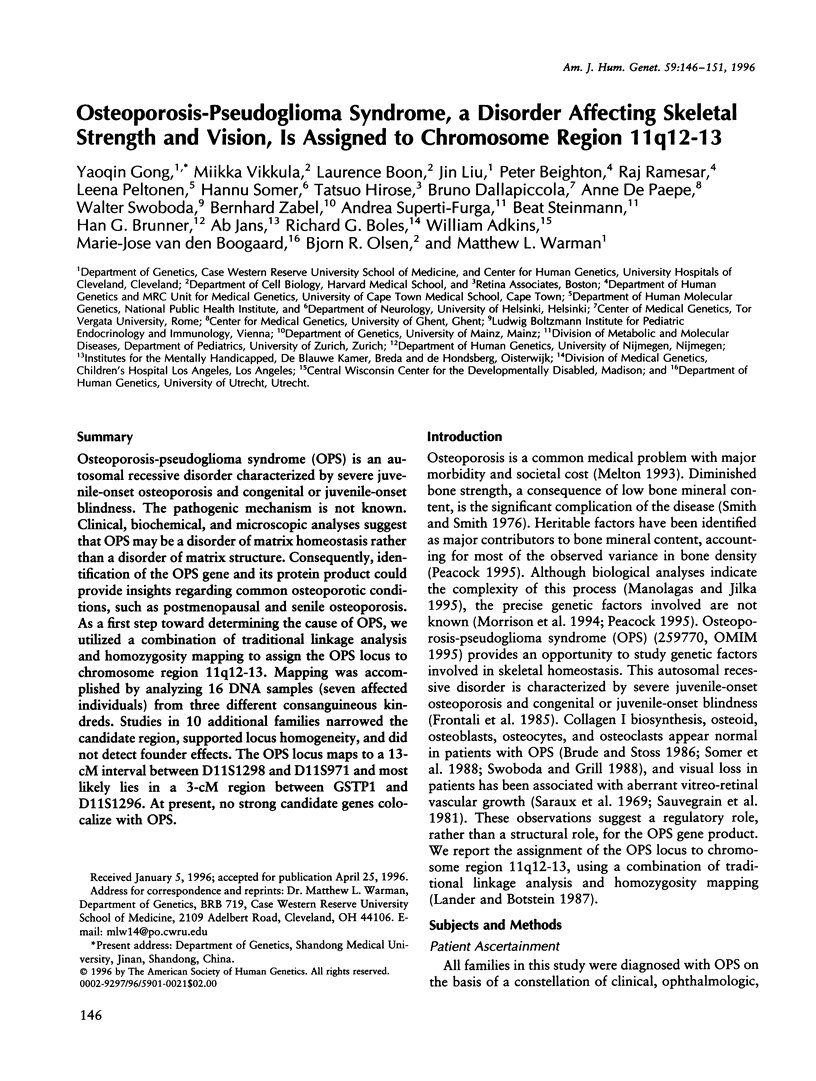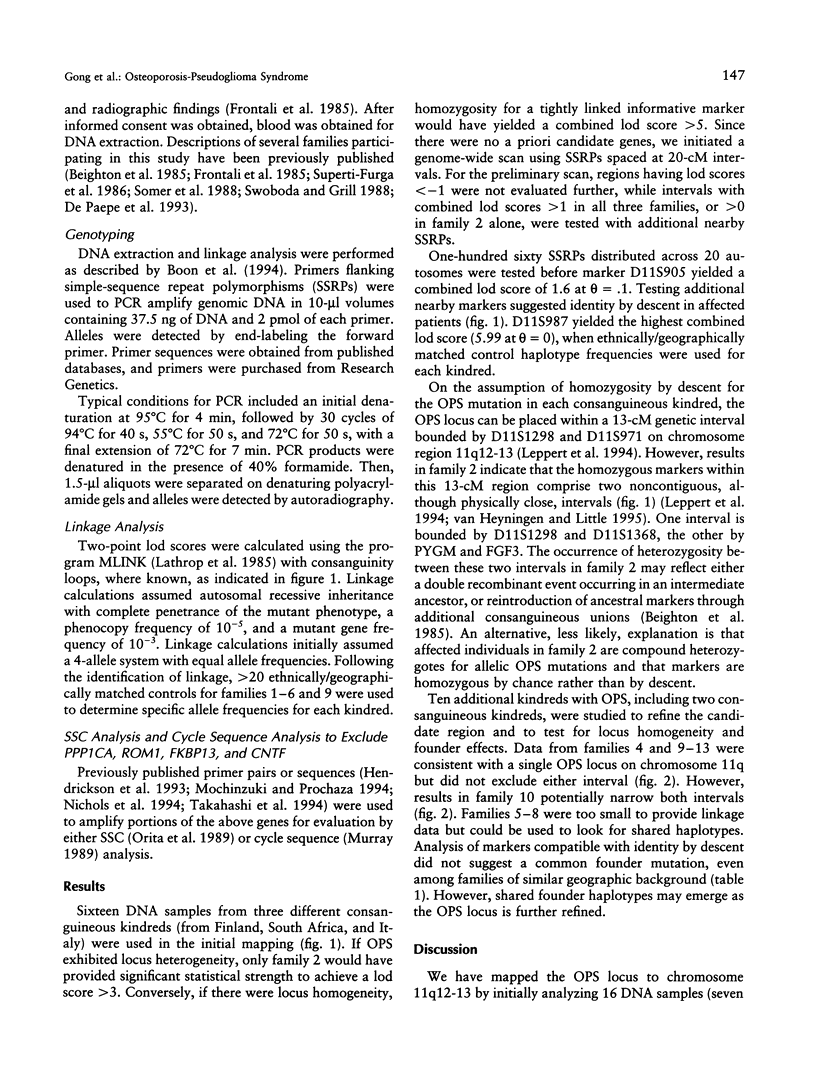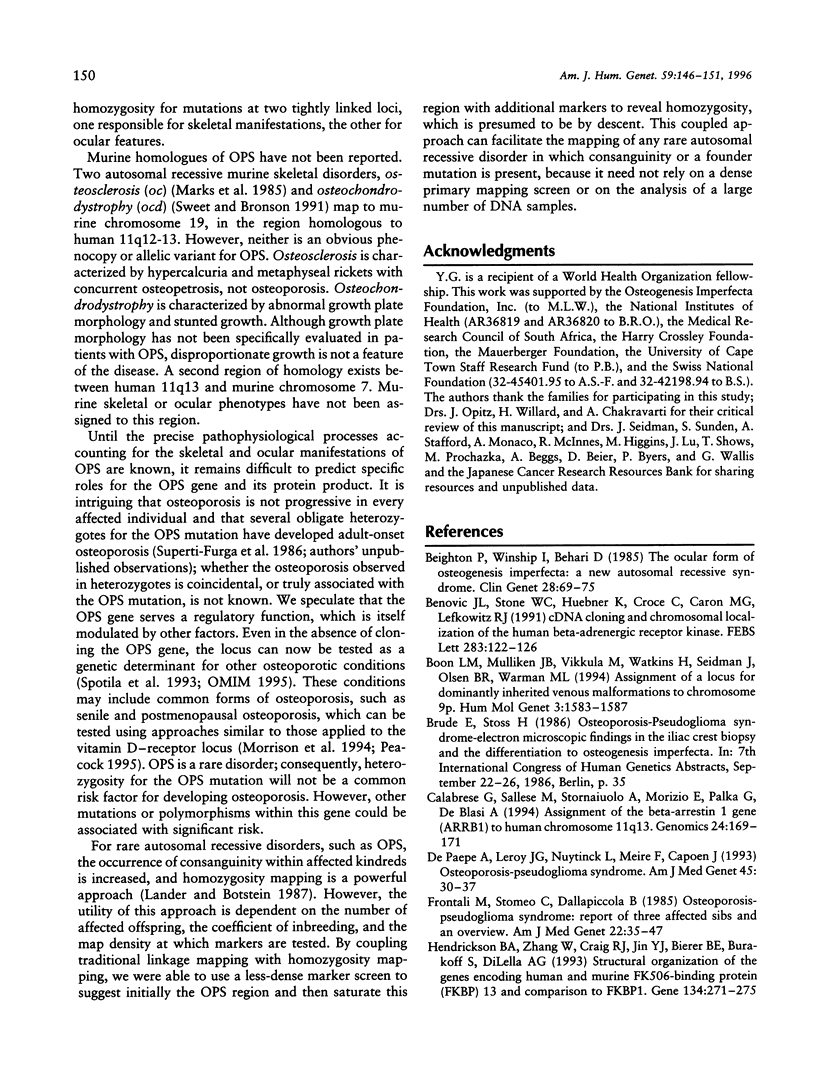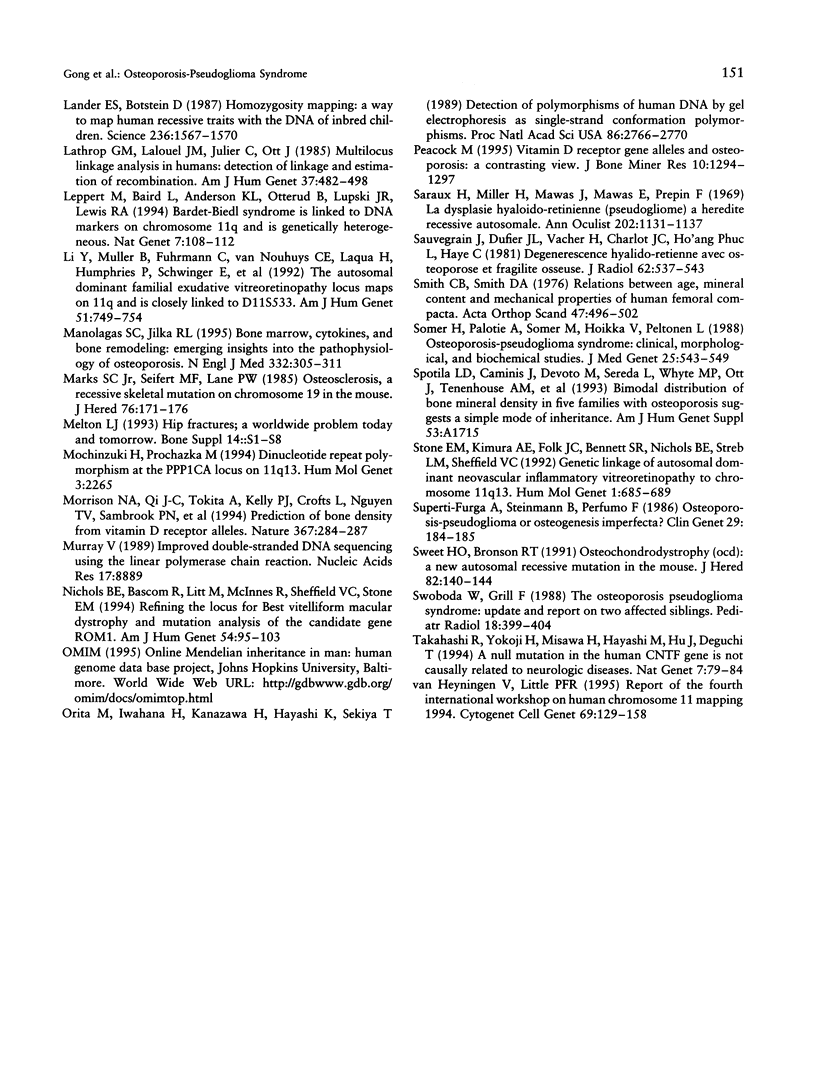Abstract
Osteoporosis-pseudoglioma syndrome (OPS) is an autosomal recessive disorder characterized by severe juvenile-onset osteoporosis and congenital or juvenile-onset blindness. The pathogenic mechanism is not known. Clinical, biochemical, and microscopic analyses suggest that OPS may be a disorder of matrix homeostasis rather than a disorder of matrix structure. Consequently, identification of the OPS gene and its protein product could provide insights regarding common osteoporotic conditions, such as postmenopausal and senile osteoporosis. As a first step toward determining the cause of OPS, we utilized a combination of traditional linkage analysis and homozygosity mapping to assign the OPS locus to chromosome region 11q12-13. Mapping was accomplished by analyzing 16 DNA samples (seven affected individuals) from three different consanguineous kindreds. Studies in 10 additional families narrowed the candidate region, supported locus homogeneity, and did not detect founder effects. The OPS locus maps to a 13-cM interval between D11S1298 and D11S971 and most likely lies in a 3-cM region between GSTP1 and D11S1296. At present, no strong candidate genes colocalize with OPS.
Full text
PDF





Selected References
These references are in PubMed. This may not be the complete list of references from this article.
- Beighton P., Winship I., Behari D. The ocular form of osteogenesis imperfecta: a new autosomal recessive syndrome. Clin Genet. 1985 Jul;28(1):69–75. doi: 10.1111/j.1399-0004.1985.tb01220.x. [DOI] [PubMed] [Google Scholar]
- Benovic J. L., Stone W. C., Huebner K., Croce C., Caron M. G., Lefkowitz R. J. cDNA cloning and chromosomal localization of the human beta-adrenergic receptor kinase. FEBS Lett. 1991 May 20;283(1):122–126. doi: 10.1016/0014-5793(91)80568-n. [DOI] [PubMed] [Google Scholar]
- Boon L. M., Mulliken J. B., Vikkula M., Watkins H., Seidman J., Olsen B. R., Warman M. L. Assignment of a locus for dominantly inherited venous malformations to chromosome 9p. Hum Mol Genet. 1994 Sep;3(9):1583–1587. doi: 10.1093/hmg/3.9.1583. [DOI] [PubMed] [Google Scholar]
- Calabrese G., Sallese M., Stornaiuolo A., Morizio E., Palka G., De Blasi A. Assignment of the beta-arrestin 1 gene (ARRB1) to human chromosome 11q13. Genomics. 1994 Nov 1;24(1):169–171. doi: 10.1006/geno.1994.1594. [DOI] [PubMed] [Google Scholar]
- De Paepe A., Leroy J. G., Nuytinck L., Meire F., Capoen J. Osteoporosis-pseudoglioma syndrome. Am J Med Genet. 1993 Jan 1;45(1):30–37. doi: 10.1002/ajmg.1320450110. [DOI] [PubMed] [Google Scholar]
- Frontali M., Stomeo C., Dallapiccola B. Osteoporosis-pseudoglioma syndrome: report of three affected sibs and an overview. Am J Med Genet. 1985 Sep;22(1):35–47. doi: 10.1002/ajmg.1320220104. [DOI] [PubMed] [Google Scholar]
- Hendrickson B. A., Zhang W., Craig R. J., Jin Y. J., Bierer B. E., Burakoff S., DiLella A. G. Structural organization of the genes encoding human and murine FK506-binding protein (FKBP) 13 and comparison to FKBP1. Gene. 1993 Dec 8;134(2):271–275. doi: 10.1016/0378-1119(93)90106-d. [DOI] [PubMed] [Google Scholar]
- Lander E. S., Botstein D. Homozygosity mapping: a way to map human recessive traits with the DNA of inbred children. Science. 1987 Jun 19;236(4808):1567–1570. doi: 10.1126/science.2884728. [DOI] [PubMed] [Google Scholar]
- Lathrop G. M., Lalouel J. M., Julier C., Ott J. Multilocus linkage analysis in humans: detection of linkage and estimation of recombination. Am J Hum Genet. 1985 May;37(3):482–498. [PMC free article] [PubMed] [Google Scholar]
- Leppert M., Baird L., Anderson K. L., Otterud B., Lupski J. R., Lewis R. A. Bardet-Biedl syndrome is linked to DNA markers on chromosome 11q and is genetically heterogeneous. Nat Genet. 1994 May;7(1):108–112. doi: 10.1038/ng0594-108. [DOI] [PubMed] [Google Scholar]
- Li Y., Müller B., Fuhrmann C., van Nouhuys C. E., Laqua H., Humphries P., Schwinger E., Gal A. The autosomal dominant familial exudative vitreoretinopathy locus maps on 11q and is closely linked to D11S533. Am J Hum Genet. 1992 Oct;51(4):749–754. [PMC free article] [PubMed] [Google Scholar]
- Manolagas S. C., Jilka R. L. Bone marrow, cytokines, and bone remodeling. Emerging insights into the pathophysiology of osteoporosis. N Engl J Med. 1995 Feb 2;332(5):305–311. doi: 10.1056/NEJM199502023320506. [DOI] [PubMed] [Google Scholar]
- Marks S. C., Jr, Seifert M. F., Lane P. W. Osteosclerosis, a recessive skeletal mutation on chromosome 19 in the mouse. J Hered. 1985 May-Jun;76(3):171–176. doi: 10.1093/oxfordjournals.jhered.a110059. [DOI] [PubMed] [Google Scholar]
- Mochizuki H., Prochazka M. Dinucleotide repeat polymorphism at the PPP1CA locus on 11q13. Hum Mol Genet. 1994 Dec;3(12):2265–2265. doi: 10.1093/hmg/3.12.2265. [DOI] [PubMed] [Google Scholar]
- Morrison N. A., Qi J. C., Tokita A., Kelly P. J., Crofts L., Nguyen T. V., Sambrook P. N., Eisman J. A. Prediction of bone density from vitamin D receptor alleles. Nature. 1994 Jan 20;367(6460):284–287. doi: 10.1038/367284a0. [DOI] [PubMed] [Google Scholar]
- Murray V. Improved double-stranded DNA sequencing using the linear polymerase chain reaction. Nucleic Acids Res. 1989 Nov 11;17(21):8889–8889. doi: 10.1093/nar/17.21.8889. [DOI] [PMC free article] [PubMed] [Google Scholar]
- Nichols B. E., Bascom R., Litt M., McInnes R., Sheffield V. C., Stone E. M. Refining the locus for Best vitelliform macular dystrophy and mutation analysis of the candidate gene ROM1. Am J Hum Genet. 1994 Jan;54(1):95–103. [PMC free article] [PubMed] [Google Scholar]
- Orita M., Iwahana H., Kanazawa H., Hayashi K., Sekiya T. Detection of polymorphisms of human DNA by gel electrophoresis as single-strand conformation polymorphisms. Proc Natl Acad Sci U S A. 1989 Apr;86(8):2766–2770. doi: 10.1073/pnas.86.8.2766. [DOI] [PMC free article] [PubMed] [Google Scholar]
- Peacock M. Vitamin D receptor gene alleles and osteoporosis: a contrasting view. J Bone Miner Res. 1995 Sep;10(9):1294–1297. doi: 10.1002/jbmr.5650100904. [DOI] [PubMed] [Google Scholar]
- Saraux H., Miller H., Mawas J., Mawas E., Prépin F. La dysplasie hyaloïdo-rétinienne (pseudogliome) à hérédité récessive autosomale. Ann Ocul (Paris) 1969 Nov;202(11):1131–1137. [PubMed] [Google Scholar]
- Sauvegrain J., Dufier J. L., Vacher H., Charlot J. C., Ho'Ang Phuc L., Haye C. Dénénérescence hyalido-rétinienne avec ostéoporose et fragilité osseuse. Psesudo-gliome avec fragilité osseuse. J Radiol. 1981 Oct;62(10):537–543. [PubMed] [Google Scholar]
- Smith C. B., Smith D. A. Relations between age, mineral density and mechanical properties of human femoral compacta. Acta Orthop Scand. 1976 Oct;47(5):496–502. doi: 10.3109/17453677608988727. [DOI] [PubMed] [Google Scholar]
- Somer H., Palotie A., Somer M., Hoikka V., Peltonen L. Osteoporosis-pseudoglioma syndrome: clinical, morphological, and biochemical studies. J Med Genet. 1988 Aug;25(8):543–549. doi: 10.1136/jmg.25.8.543. [DOI] [PMC free article] [PubMed] [Google Scholar]
- Stone E. M., Kimura A. E., Folk J. C., Bennett S. R., Nichols B. E., Streb L. M., Sheffield V. C. Genetic linkage of autosomal dominant neovascular inflammatory vitreoretinopathy to chromosome 11q13. Hum Mol Genet. 1992 Dec;1(9):685–689. doi: 10.1093/hmg/1.9.685. [DOI] [PubMed] [Google Scholar]
- Superti-Furga A., Steinmann B., Perfumo F. Osteoporosis-pseudoglioma or osteogenesis imperfecta? Clin Genet. 1986 Feb;29(2):184–185. doi: 10.1111/j.1399-0004.1986.tb01249.x. [DOI] [PubMed] [Google Scholar]
- Sweet H. O., Bronson R. T. Osteochondrodystrophy (ocd): a new autosomal recessive mutation in the mouse. J Hered. 1991 Mar-Apr;82(2):140–144. doi: 10.1093/oxfordjournals.jhered.a111048. [DOI] [PubMed] [Google Scholar]
- Swoboda W., Grill F. The osteoporosis pseudoglioma syndrome. Update and report on two affected siblings. Pediatr Radiol. 1988;18(5):399–404. doi: 10.1007/BF02388045. [DOI] [PubMed] [Google Scholar]
- Takahashi R., Yokoji H., Misawa H., Hayashi M., Hu J., Deguchi T. A null mutation in the human CNTF gene is not causally related to neurological diseases. Nat Genet. 1994 May;7(1):79–84. doi: 10.1038/ng0594-79. [DOI] [PubMed] [Google Scholar]
- van Heyningen V., Little P. F. Report of the fourth international workshop on human chromosome 11 mapping 1994. Cytogenet Cell Genet. 1995;69(3-4):127–158. doi: 10.1159/000133953. [DOI] [PubMed] [Google Scholar]


